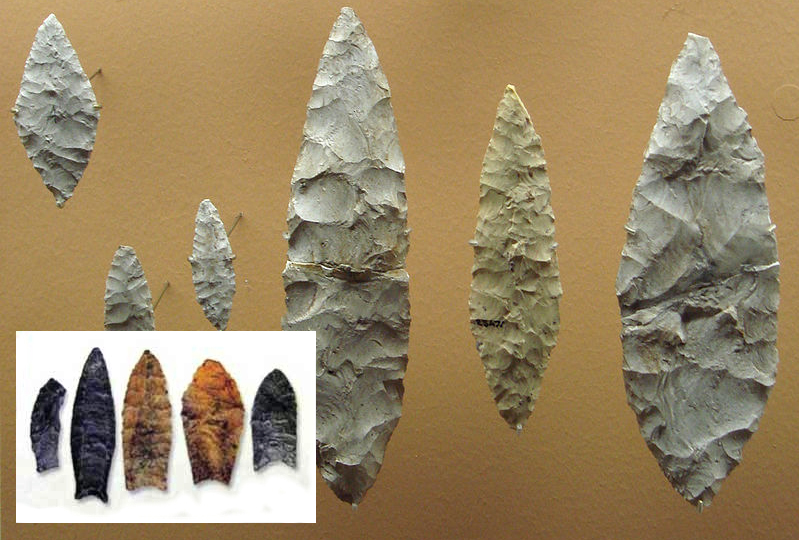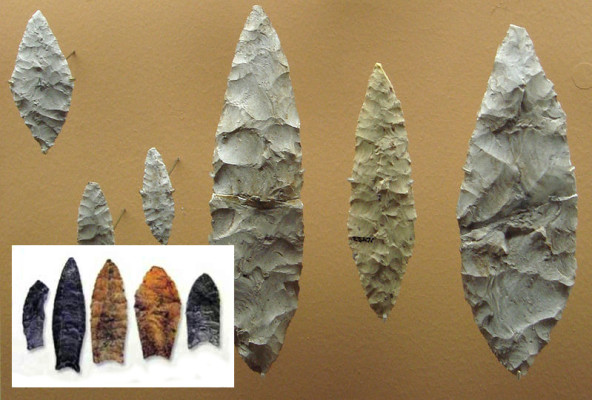Many scientists are still working on proving a theory called the “ice bridge” theory, which proposes that humans migrated from Siberia to Alaska by means of a land bridge spanning the Bering Strait, or that North America was first settled by Upper Palaeolithic people from Europe moving through Greenland via a glacial bridge.
In the 1970s a ship and crew hunting for scallops in Chesapeake Bay hit a snag and pulled up what is purported to be an ancient stone blade with pieces of a mastodon skeleton attached. Using carbon dating from the animal remains, scientists dated the blade at an estimated 22,000 years old.
A boon to the ice bridge theory is that more pieces of stone blades have been found in the same area. One of the more recent finds is thought to belong to the Solutrean foragers of western Europe – anthropologists insist that this culture began around 22,000 to 17,000 years ago, and possibly these people populated North America. (PastHorizons)
A few scholars actually doubt the accounts of the blade and mastodon. Though records were made of the coordinates and water depth of the find, there are many skeptics that feel the pieces of information do not add up. One particular scientist says that because there are more inconsistencies in the story than there are actual findings, this story is not even counted as part of the proof for the ice bridge theory.
While the mainstream of the archaeological community is in general agreement that the Americas were settled by migrants sourced from northeastern Asian populations, uncertainties remain as to the chronology of the migrations, the source populations that contributed to the migrations, and the migration routes. The uncertainty is fed by a lack of archaeological evidence along migration routes dating to the periods when migrations are proposed to have occurred; uncertainties in the dating and interpretation of the oldest proposed archaeosites in the Americas; and uncertainties of assumptions underlying chronological and source models of migration derived from studies of modern Native American genetics.
In the early 21st century, the chronology of migration models is divided into two general approaches.The first is the short chronology theory, based on the concept that the first migration into the New World occurred after the LGM, which went into decline after about 19k cal years BP, then was followed by successive waves of immigrants. The second is the long chronology theory, which proposes that the first group of people entered the Americas at a much earlier date, possibly 21k–40k cal years BP, with a much later second wave of immigrants. Further controversy has been generated as age-dating of archaeosites in the Americas and the timing of the opening of the ice-free corridor have challenged the Clovis First theory, which dominated thinking on New World anthropology for much of the 20th century.
Archaeological evidence
Pre-LGM migration across Beringia into the Americas has been proposed to explain purported pre-LGM ages of archaeosites in the Americas such as Bluefish Caves and Old Crow Flats in the Yukon Territory, and Meadowcroft Rock Shelter in Pennsylvania. The earlier 14C date from a bone artifact at the Old Crow Flats site has been supplanted by an Accelerator Mass Sectrometry 14C date indicating a Holocene age. The interpretations of butcher marks and geologic association of bones at the Bluefish Cave and Old Crow Flats sites have been called into question. The ages of the earliest positively identified artifacts at the Meadowcroft site are constrained by a compiled age estimate from 14C dates in the range of 12k-15k 14C years BP (13.8k-18.5k cal years BP). The Meadowcroft Rockshelter site and the Monte Verde site in southern Chile, with a date of 14.8k cal years BP, are the archaeosites in the Americas with the oldest dates that have gained broad acceptance.
The Yana River Rhino Horn site has dated human occupation of eastern Arctic Siberia to 27k 14C years BP (31.3k cal years BP). The early date for humans at that location has been interpreted by some as evidence that migration into Beringia was imminent, lending credence to occupation of Beringia during the LGM. However, the Yana RHS date is from the beginning of the cooling period that led into the LGM. A compilation of archaeosite dates throughout eastern Siberia is suggestive that the cooling period caused a retreat of humans towards southern refugia. Pre-LGM lithic assemblages in Siberia indicate a geographically restricted lifestyle based on utilizing local resources, while post-LGM lithic assemblages indicate a more migratory lifestyle.
The oldest archaeosite dates on the Alaskan side of Beringia are around 12k 14C years BP (14k cal years BP). That does not preclude that a small founder population had entered Beringia before that time and that the appearance of an archaeological trace reflects population expansion rather than earliest migration. However, in the absence of dated archaeosites closer to the LGM on either the Siberian or the Alaskan side of Beringia, convincing evidence of pre-LGM migration into Beringia is lacking.



!["Maps depicting each phase of the three-step early human migrations for the peopling of the Americas. (A) Gradual population expansion of the Amerind ancestors from their East Central Asian gene pool (blue arrow). (B) Proto-Amerind occupation of Beringia with little to no population growth for ≈20,000 years. (C) Rapid colonization of the New World by a founder group migrating southward through the ice-free, inland corridor between the eastern Laurentide and western Cordilleran Ice Sheets (green arrow) and/or along the Pacific coast (red arrow). In (B), the exposed seafloor is shown at its greatest extent during the last glacial maximum at ≈20–18 kya [25]. In (A) and (C), the exposed seafloor is depicted at ≈40 kya and ≈16 kya, when prehistoric sea levels were comparable. A scaled-down version of Beringia today (60% reduction of A–C) is presented in the lower left corner. This smaller map highlights the Bering Strait that has geographically separated the New World from Asia since ≈11–10 kya."](https://upload.wikimedia.org/wikipedia/commons/thumb/d/d7/Journal.pone.0001596.g004.png/270px-Journal.pone.0001596.g004.png)